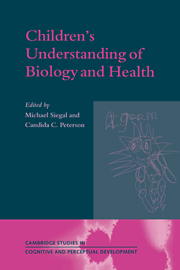Book contents
- Frontmatter
- Contents
- List of contributors
- Preface
- 1 Becoming mindful of biology and health: an introduction
- Part I Development of biological understanding
- Part II Health issues
- 5 What young children's understanding of contamination and contagion tells us about their concepts of illness
- 6 Children and pain
- 7 Children and food
- 8 The ethics of emaciation: moral connotations of body, self, and diet
- Part III Applications
- Appendix: Hypothetical dilemma vignettes
- Author index
- Subject index
8 - The ethics of emaciation: moral connotations of body, self, and diet
Published online by Cambridge University Press: 06 July 2010
- Frontmatter
- Contents
- List of contributors
- Preface
- 1 Becoming mindful of biology and health: an introduction
- Part I Development of biological understanding
- Part II Health issues
- 5 What young children's understanding of contamination and contagion tells us about their concepts of illness
- 6 Children and pain
- 7 Children and food
- 8 The ethics of emaciation: moral connotations of body, self, and diet
- Part III Applications
- Appendix: Hypothetical dilemma vignettes
- Author index
- Subject index
Summary
Body and society
Throughout time and across cultures, the body and its primary form of material transaction with the environment, eating, have been the subjects of intense moral symbolism and attempts to regulate, restrict, and control (Douglas, 1966; Nemeroff and Rozin, 1989; Rozin, 1990, 1996). Modifications to the body serve a variety of functions, from simple ornamentation (e.g., earrings in modern western society) to rites of passage (e.g., subincision among Australian Aborigines), marks of group affliation (e.g., circumcision among week-old Jewish males) or station in life (e.g., the dot on the forehead worn by Hindu Indian women or tattooing upon earning a master's rating among traditional Manx sailors). Jewelry, makeup, and fashions in clothing are ancient and more or less universal, as are religious and spiritual practices involving control over food and sex, abstentions and purges, and “mortifications of the flesh.” Clearly, management of the body – its appearance, its boundaries, what goes in and what comes out – is a potent means of managing both the social and the personal image of self (Douglas, 1966; Nemeroff et al., 1996).
Within the current western cultural context, thinness (and to a growing extent, fitness and healthiness) has come to represent virtue, success, and status. This is especially so for women. Many authors have speculated as to the exact nature of the symbolism involved.
- Type
- Chapter
- Information
- Children's Understanding of Biology and Health , pp. 183 - 206Publisher: Cambridge University PressPrint publication year: 1999
- 3
- Cited by

